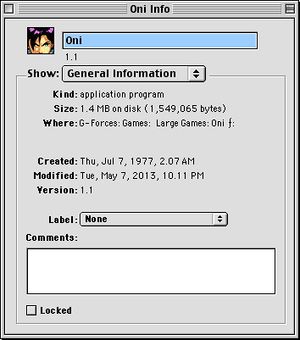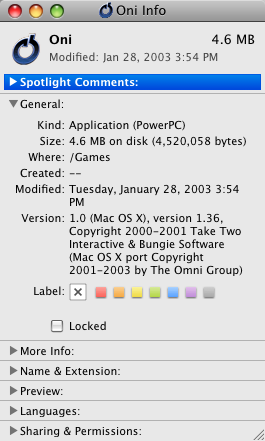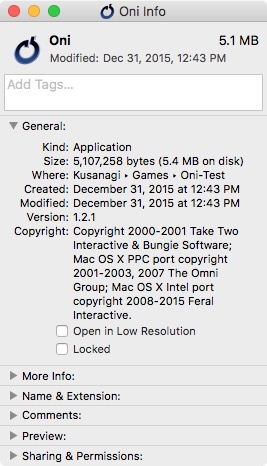History of Mac Oni: Difference between revisions
(→Windows Oni 1.0 to Mac Oni 1.1: clarifying the actual date span between non-sep-using Oni and sep-using Oni) |
m (→Classic to Carbon: making more succinct; we don't need to cover every major transition, plus there's more than 3 anyway) |
||
| Line 11: | Line 11: | ||
==Classic to Carbon== | ==Classic to Carbon== | ||
When Oni began development in 1997, Apple was about to release Mac OS 8, but it was still based on System 1.0 from 1984, and they were hoping to start fresh with a new OS as soon as possible. To that end, Apple acquired Steve Jobs' company [[wikipedia:NeXT|NeXT]] in order to use their OS, OPENSTEP, as the basis for Apple's new OS. This culminated with the release of Mac OS X in spring 2001 — awkward timing for Oni. (Note that Mac OS X was renamed "macOS" in 2016, but this article uses the original name of the OS for historical consistency.) | |||
In 2000, Bungie was merging into Microsoft, and Take-Two was assuming command of the Oni IP. Having been in development years before Mac OS X released, Mac Oni would initially have been built as a "Classic" app, referring to the Classic Mac OS ( | In 2000, Bungie was merging into Microsoft, and Take-Two was assuming command of the Oni IP. Having been in development years before Mac OS X released, Mac Oni would initially have been built as a "Classic" app, referring to the Classic Mac OS (OS 9 or earlier). Given the circumstances, the best that Bungie could do for compatibility before Oni released in January 2001 was to build the Oni application as a "Carbon" app. Carbon apps could be written primarily for OS 9 and still run in OS X. Unfortunately, the Carbon build of Oni was not without issues in the OS X environment. | ||
<div class="div-col columns column-count column-count-2 style="-moz-column-count:2; -webkit-column-count:2; column-count:2;"> | <div class="div-col columns column-count column-count-2 style="-moz-column-count:2; -webkit-column-count:2; column-count:2;"> | ||
==Carbon to Cocoa== | ==Carbon to Cocoa== | ||
[[Image:Omni Oni Get Info window.png|thumb|The Omni Group's Cocoa PPC port of Oni for Mac OS X.]] | [[Image:Omni Oni Get Info window.png|thumb|The Omni Group's Cocoa PPC port of Oni for Mac OS X.]] | ||
Revision as of 00:38, 13 May 2020
- For the overall history of Oni's development, see Oni.
Windows Oni 1.0 to Mac Oni 1.1
While Oni was developed by Bungie West simultaneously for Windows and Mac OS (with the PlayStation 2 port being done in parallel by Rockstar), the game's development was not completed for both PC platforms at the same time. Oni was gold-mastered for Windows around 11/17/2000. The Mac version continued in development for another month, partly due to a graphics bug discovered at the last minute, and probably gold-mastered on 12/21/00 (the date on the retail files, and the day before the Mac demo came out).
It appears that the Mac version of Oni required a change to the layout of the game data files (the addition of .sep files; see Windows Oni vs. Mac Oni for details). The required changes to Oni's code were made not long after the final build of the Windows Oni application, as the date of the game data on the Windows CD-ROM is 11/4/00 (the application is dated 11/3/00), and the date on the Mac game data is 11/20/00. Because the Windows demo was not released until around 12/17/00, it was built on the version of Oni that used .sep files, unlike Windows retail Oni.
As a result of reaching gold status first, the Windows retail Oni application is version 1.0 (as seen in the Windows read-me), and Bungie's build of the game app for the Mac was version 1.1 (pictured, right; also see the Mac read-me). Besides any fixes to the code made after Windows Oni was gold-mastered, it's likely that additional bugs were fixed between the production of the Windows demo and the Mac release, based on issues observed in BSL in the Windows demo application that aren't present in Mac Oni. But long after Oni's release, the Mac Oni app would continue to evolve.
Classic to Carbon
When Oni began development in 1997, Apple was about to release Mac OS 8, but it was still based on System 1.0 from 1984, and they were hoping to start fresh with a new OS as soon as possible. To that end, Apple acquired Steve Jobs' company NeXT in order to use their OS, OPENSTEP, as the basis for Apple's new OS. This culminated with the release of Mac OS X in spring 2001 — awkward timing for Oni. (Note that Mac OS X was renamed "macOS" in 2016, but this article uses the original name of the OS for historical consistency.)
In 2000, Bungie was merging into Microsoft, and Take-Two was assuming command of the Oni IP. Having been in development years before Mac OS X released, Mac Oni would initially have been built as a "Classic" app, referring to the Classic Mac OS (OS 9 or earlier). Given the circumstances, the best that Bungie could do for compatibility before Oni released in January 2001 was to build the Oni application as a "Carbon" app. Carbon apps could be written primarily for OS 9 and still run in OS X. Unfortunately, the Carbon build of Oni was not without issues in the OS X environment.
Carbon to Cocoa
Then, at the end of 2001, The Omni Group released a "Cocoa" (native OS X) build of the game which they had produced for free. This became known as the Omni build (now often referred to as the PPC build to differentiate it from the later Intel build). Their OS X builds (released through 2003) kept Oni stable on the latest Mac OS for several years. The last Omni build is still available here. However, as computers advanced, a critical bug appeared in both Windows and Mac Oni: the game would immediately crash while querying the graphics card at startup. Once a patch, made through hex editing, was figured out in Windows, it was carried over to the PPC build. Other patches were made in time to the PPC build; see HERE for details.
PPC to Intel
In 2006 Apple began their third major Mac transition: the switch to Intel processors, back to CISC architecture and moving away from the PowerPC chip for which both Bungie and The Omni Group had built Oni. For a while, PPC apps could be run on Intel Macs using Rosetta, but support for the old architecture was expected to eventually phase out. In 2009, Feral Interactive (Oni's Mac distributor outside of North America) expressed an interest in putting out an Intel-native build of Oni. They obtained the latest version of Oni's source code from The Omni Group (who had already begun porting it to Intel), and made their initial public release of Oni for Intel Macs in the spring of 2011, a few months before the first version of OS X without Rosetta was released. The Feral build of Oni incorporates a number of changes requested by fans, detailed HERE.


